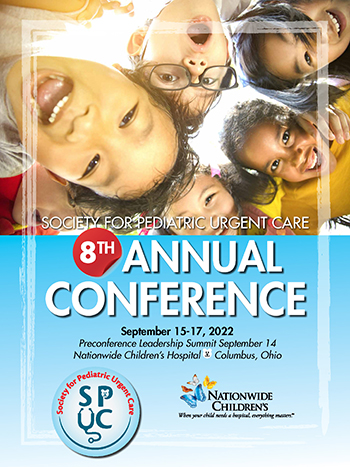FB is a 9-month-old previously healthy male who presented to an urgent care with the chief complaint of vomiting that began the night prior, with 2 episodes of large, projectile, non- bilious vomiting, about 20 minutes after formula feeds each time – once the night prior and once the morning of presentation (a few hours before this visit); infant did keep down one overnight feeding between the two episodes. On the morning of the visit infant was also noted to have nasal congestion and mild increased work of breathing, without cough; he was noted to have two wet diapers on the morning of visit. Dad reported that infant’s appetite and activity level were somewhat decreased that day. No fever, diarrhea, rhinorrhea, stridor, wheezing, ear pulling, eye redness, eye discharge, or rash. No reported injuries or falls. No home medications. No known sick contacts, no daycare attendance. Immunizations are up to date. Not seen prior for these complaints. No PMH/No surgical history.
Physical exam: Temperature 36.1 C Pulse 128 Respirations 56 weight 7.75kg SPO2 100%
General appearance: irritable, tachypneic, pale
HEENT: AFOF, atraumatic, PERRL conjunctiva clear, no eyelid swelling, TMs clear bilat, nose clear without rhinorrhea, oropharynx – clear, dry mucous membranes, no lesions. Neck: supple without adenopathy. Chest: noted tachypnea, clear equal breath sounds without adventitial sounds. CVS: tachycardia, no murmur rubs or gallops, capillary refill delayed at 3 seconds. Abdomen: soft non-tender, no masses, no hepatosplenomegaly. EXT: no deformity, swelling ecchymosis, erythema, or tenderness. SKIN: No rash, mottled. Neuro: awake alert irritable but consolable, normal tone and strength, non-focal
Differential diagnosis at this point…viral illness, acute gastroenteritis, food borne illness, sepsis, UTI, non-accidental trauma (NAT), new onset IDDM/DKA, inborn error of metabolism, non-convulsive seizures.
The next step in an Urgent Care setting: the quickest and easiest thing to start with is a POC finger stick blood glucose, which was done in this patient and was 499. Other bloodwork that can be done in an Urgent Care setting and was subsequently done on this patient to confirm the diagnosis and start management include basic chemistry panel, and CBC. Other labs that you may be able to get at your institution that may be helpful include a urinalysis, a blood gas if available and a lipid profile.
The next step was to call for immediate transfer to the local hospital, which in this case was a children’s hospital, with a phone consult with a pediatric endocrinologist, if that is available to you. While waiting for transport, fluid resuscitation was begun in the Urgent care with normal saline, which is the basis of the initial treatment of DKA from an Urgent Care standpoint.
Infants with Type 1 IDDDM are more likely to present in DKA as the diagnosis can be delayed; the diagnosis can be a challenge to diagnose in this age group, as many common symptoms we think of when we think of new onset IDDM, such as polyuria or polydipsia, headache, or abdominal pain may not be as apparent in an infant, and because infants may present earlier, (ie the history of present illness may be brief) due to earlier decompensation based on size/greater risk for acidosis and dehydration. Key points for this case are to go with your clinical instincts—this infant appeared more ill appearing than would account for in the short history, and his respiratory symptoms, (which turned out to be Kussmaul respirations), in the absence of cough or fever should point you towards a metabolic cause.
DKA occurs when there is a relative or absolute decrease in circulating insulin levels. The diagnosis of DKA is made based on the following biochemical criteria, blood glucose > 200mg/dl, a venous pH < 7.3 or a serum HCO3 < 15meq/L, and blood beta-hydroxybutyrate levels greater or equal to 3mmol/L or moderate or severe ketonuria. The differential of DKA is usually due to new onset Type 1 diabetes mellitus, but other less common causes include Type 1 DM and infection, other intercurrent illness, or less commonly Type 2 diabetics can present in DKA.
Treatment of DKA involves careful fluid resuscitation, insulin administration, electrolyte replacement, and close monitoring for signs of cerebral edema.
Diabetes is one of the most common chronic diseases in the United States; nearly 30% of children with a new diagnosis of Type 1 DM present with DKA, as well as 10% of children with Type 2 DM. Risk factors for DKA on initial diagnosis are younger age (<2years), delayed diagnosis, and lower socioeconomic status, therefore as urgent care physicians it is a good idea to keep this diagnosis in mind in our clinical practice. A good history and physical examination are necessary to prevent misdiagnosis in children who do not have the classic symptoms of DKA, such as polyuria, polydipsia, polyphagia, and weight loss. Clinical signs include vomiting, abdominal pain, dehydration, weakness, and lethargy, and may progress rapidly. Signs of dehydration include tachycardia, delayed capillary refill, poor skin turgor, and dry mucous membranes. Ketoacidosis stimulates both central and peripheral chemoreceptors that control respiration, resulting in Kussmaul respiration (rapid fast deep breathing), in an attempt to decrease PCO2 and compensate for metabolic acidosis. Ketoacidosis may also result in a fruity odor to the breath. Hypotension is a rare or late finding due to increased plasma catecholamines and increased release of antidiuretic hormone, despite the severe dehydration. The most serious complication of DKA is severe neurologic injury and cerebral edema; warning signs of this include headache, bradycardia, irritability, increased drowsiness, altered mental status, cranial nerve palsies, hypertension, unresponsiveness, and coma.
In conclusion, younger children with DKA present with signs of dehydration, and may present with Kussmaul respirations, and signs of neurologic injury. Despite advances in research and treatment, the incidence of pediatric-onset diabetes and DKA is increasing. Early diagnosis may prevent neurologic injury. Children with DKA should be cared for in a center with expertise in managing these ill patients.


